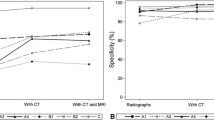Abstract
Introduction
At this hospital, computed tomography (CT) of the full spine is performed on all patients who have sustained high-energy trauma because spinal fractures can be overlooked by referring only to clinical findings and plain X-rays of the spine. The goal of this study is to prospectively detect the occurrence of spinal fractures in cases of high-energy trauma using full spine CT and to evaluate the usefulness of it.
Materials and methods
Subjects were 179 patients (134 male, 45 female) who were deemed to have sustained high-energy trauma in the 21-month period starting in September 2007. Spinal fractures initially revealed by CT were studied in detail.
Results
Spinal fractures were found in 54 patients (30.2 %); 19 patients had stable fractures, and 41 had unstable fractures. Forty patients had concomitant injuries to organs in addition to spinal injury; these patients had an average Injury Severity Score of 20.2 (4–70). Of 16 patients with a cervical fracture, 6 (37.5 %) had a fracture that did not appear on plain X-rays of the cervical and that was first identified by CT. Of 43 patients with a thoracolumbar fracture, 6 (14.0 %) had a fracture that would have been difficult to detect if a full spine CT had not been done.
Conclusion
In patients who have sustained high-energy trauma, spinal fractures may be overlooked during primary care by a diagnosis based only on plain X-rays and clinical manifestations. Therefore, patients who have sustained high-energy trauma should be evaluated with full spine CT during primary care.





Similar content being viewed by others
References
Yokota J (2006) Guideline for initial trauma care in Japan: Japan Advanced Trauma Evaluation and Care (JATEC), 2nd edn. Herusu-shuppan, Tokyo. Japanese
Widder S, Doig C, Burrowes P, Larsen G, Hurlbert RJ, Kortbeek JB (2004) Prospective evaluation of computed tomographic scanning for the spinal clearance of obtunded trauma patients: preliminary results. J Trauma 56:1179–1184
Diaz JJ Jr, Gillman C, Morris JA Jr, May AK, Carrillo YM, Guy J (2003) Are five-view plain films of the cervical spine unreliable? A prospective evaluation in blunt trauma patients with altered mental status. J Trauma 55:658–663
Schenarts PJ, Diaz J, Kaiser C, Carrillo Y, Eddy V, Morris JA Jr (2001) Prospective comparison of admission computed tomographic scan and plain films of the upper cervical spine in trauma patients with altered mental status. J Trauma 51:663–669
Tajima K, Kouno K, Sasaki T, Yamanaka K, Nomoto S, Kikuchi K (2005) Usefulness of routine cervical CT in high energy head injury patients. 14 cases of “occult fracture” found during cervical CT scans. Rinsho Seikei Geka (Clin Orthop Surg) 40:1307–1312
Sampson MA, Colquhoun KBM, Hennessy NLM (2006) Computed tomography whole body imaging in multi-trauma: 7 years experience. Clin Radiol 61:365–369
Dai LY, Yao WF, Cui YM, Zhou Q (2004) Thoracolumbar fractures in patients with multiple injuries: diagnosis and treatment-a review of 147 cases. J Trauma 56:348–355
Anderson S, Biros MH, Reardon RF (1996) Delayed diagnosis of thoracolumbar fractures in multiple-trauma patients. Acad Emerg Med 3:832–839
Hoffman JR, Mower WR, Wolfson AB, Todd KH, Zucker MI, For the National Emergency X-Radiography Utilization Study Group (2000) Validity of a set of clinical criteria to rule out injury to the cervical spine in patients with blunt trauma. N Engl J Med 343:94–99
Bandiera G, Stiell IG, Wells GA, Clement C, De Maio V, Vandemheen KL, Greenberg GH, Lesiuk H, Brison R, Cass D, Dreyer J, Eisenhauer MA, Macphail I, McKnight RD, Morrison L, Reardon M, Schull M, Worthington J, Canadian C-Spine and CT Head Study Group (2003) The Canadian C-spine rule performs better than unstructured physician judgment. Ann Emerg Med 42:395–402
Conflict of interest
All authors have received no benefits or funds in support of this study.
Author information
Authors and Affiliations
Corresponding author
Rights and permissions
About this article
Cite this article
Takami, M., Nohda, K., Sakanaka, J. et al. Usefulness of full spine computed tomography in cases of high-energy trauma: a prospective study. Eur J Orthop Surg Traumatol 24 (Suppl 1), 167–171 (2014). https://doi.org/10.1007/s00590-013-1268-0
Received:
Accepted:
Published:
Issue Date:
DOI: https://doi.org/10.1007/s00590-013-1268-0




